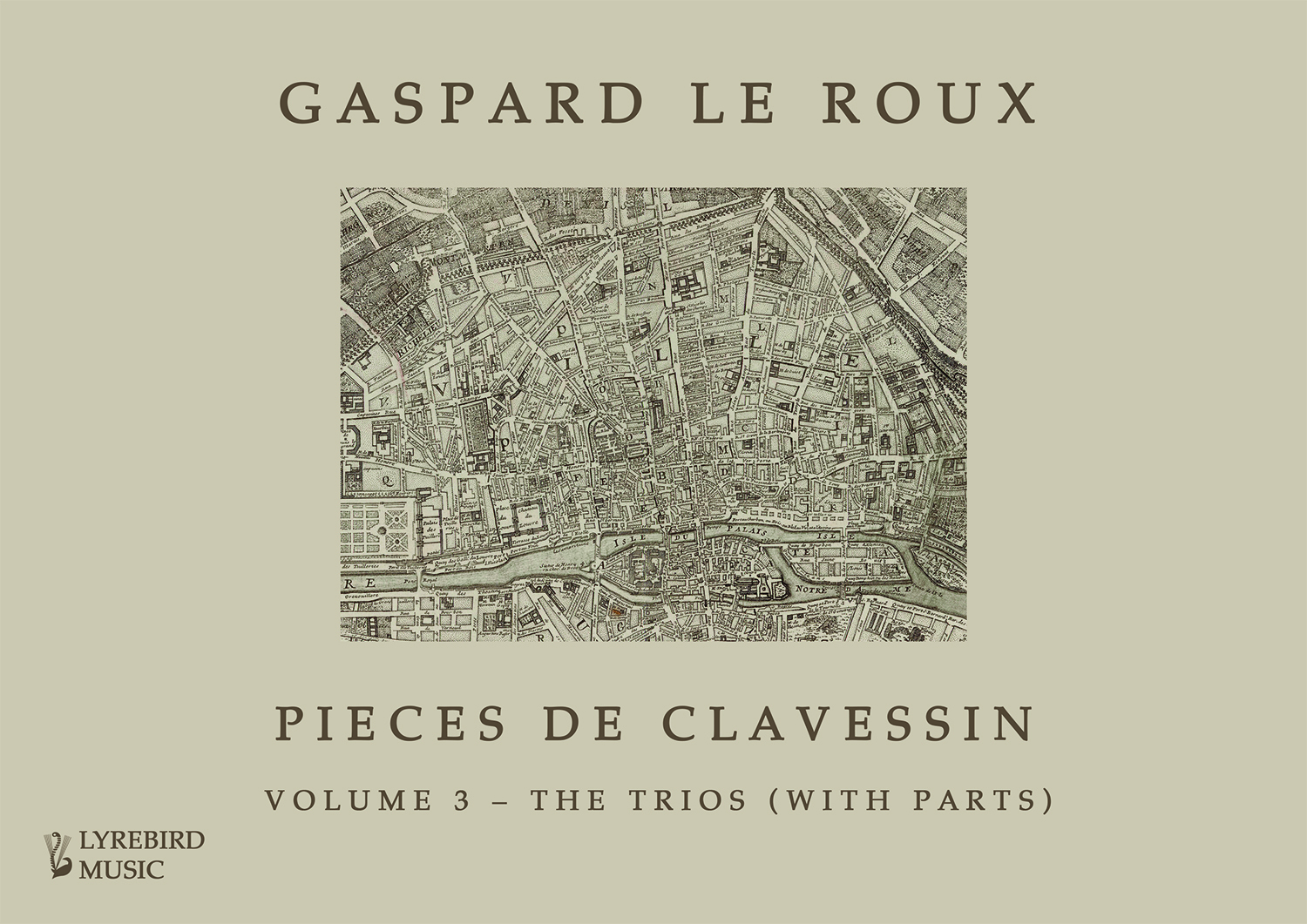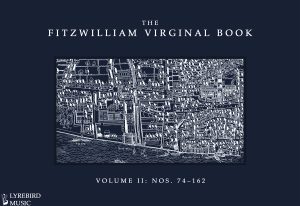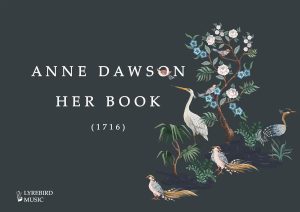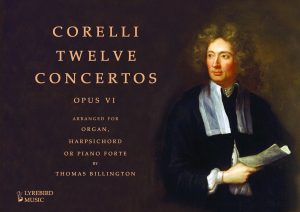LBMP–007: Gaspard Le Roux – Pieces de clavessin Volume 3: The Trios and Parts
€32.04 – €40.88 (+ VAT for EU customers)
ISMN 979-0-706670-05-8 (Hardback) | 979-0-706670-27-0 (Wire)
119 pages
Edited by Jon Baxendale
- Full score of all three parts
- Photocopiable parts for ensemble use
- Premier partie for treble instrument
- Contrepartie for treble instrument
- Troisième partie for bass instrument
- Bass continuo
- Three available formats
-
- Colour hardback cover with a matt finish (choice on checkout)
- Wire-bound with soft colour cover (choice on checkout)
- Tablet (PDF – one download available for 5 days)
-
Prices vary according to your needs. Please first choose the format you require.
Gaspard Le Roux was a musician working in late seventeenth- and early eighteenth-century Paris. Little is known of his life, other than a few brief mentions in the cheque books of public notaries. His birth date is unknown, and while the belief that he died in 1707 is widely accepted, new research by editor Jon Baxendale has established this to be incorrect.
The Pieces de clavessin contains seven suites that are demonstrative, providing examples of both Italian and French styles of writing. They are among the most charming of the Grand siècle and deserve a place alongside the works of François Couperin and Jean-Philippe Rameau.
They are also unusual. Trying to maximise the appeal of his publication, Le Roux included the earliest printed duo for two harpsichords and provided five examples of how the other pieces in the book might be similarly arranged. Additionally, Le Roux transcribed the pièces for unspecified trio instruments with basso continuo.
Volume 1 contains the harpsichord pieces and the duo. Its substantial preface discusses the current state of research on this most enigmatic of composers and goes in search of the real Gaspard Le Roux. A bibliographical section discusses not only the 1705 Paris imprint but also a bootleg copy made by Estienne Roger and a manuscript copied by J G Walther. David Ledbetter has provided a detailed section on performance practice.
In Volume 2, Baxendale picks up where Le Roux left off. Starting with his five examples, the remaining 42 pieces have been arranged for duo performance. Volume 3 contains the trios with photocopiable parts for ensemble musicians.
This Lyrebird publication is the only available edition of his music.
Review snippets:
In a long preface, historical records, past assumptions, misunderstandings and mistakes are pursued with forensic skill and persistence …
Derek Adlam
– National Early Music Association Journal
L’appareil critique est excellent, laissant deviner à la fois la rigueur et l’enthousiasme de J. Baxendale.
Pascal Tuffery
– Clavecin en France
DEREK ADLAM
REVIEW FOR THE NATIONAL EARLY MUSIC ASSOCIATION
Pieces de Clavessin Composées Par Gaspard Le Roux Avec la maniere de les Joüer, Paris, 1705. Edited and with a Preface by Jon Baxendale. Notes on performance by David Ledbetter.
[Lyrebird Music] has issued a fine new edition by Jon Baxendale of Gaspard Le Roux’s Pieces de Clavessin, Avec la maniere de les Joüer. This collection of seven suites was first published in Paris in 1705, followed about three years later by an apparently unauthorised print by Estienne Roger of Amsterdam. Of these two prints, only three complete examples survive, though there is evidence, not least the publication of the pirate edition, to suggest that the music circulated quite widely. Johann Gottlieb Walther made a copy of some of the music and referred to the Amsterdam print in his Musicalisches Lexicon of 1732. Although these subsequent sources might be thought irrelevant to Le Roux’s intentions, both are of interest. Roger did not reproduce exactly the notation of the original Paris issue, but made small adjustments that increasingly were to become part of a European standard. His distribution system crossed national boundaries, so his scores reached the widest possible audience. Surprisingly, though Walther in his Lexicon refers only to the Amsterdam print, his copies from the suites are based on the original Paris print. These introduce a number of extra ornaments appearing to encourage or simulate a manner of performance reflecting the artlessness and flexibility associated with le bon goût. This manuscript was also consulted where certain ambiguities arise in the original print, a few variants being introduced as ossias […] Apart from the charm of the music itself, a feature that particularly attracts us is Le Roux’s provision of a separate Gigue for two harpsichords, and a series of contreparties which may be played on a second harpsichord to accompany five of the pieces from the suites. It is clear from Le Roux’s own text that he considers most of his pieces make a great effect when played with a contrepartie, and in giving these examples he is inviting performers to write, or perhaps more to the point, improvise their own accompaniments to his works.
This new critical edition is in three volumes, the first presenting the pieces described above as they appeared in the 1705 print. In the second volume, Baxendale reprints the original duet versions, and then, taking Le Roux at his word, presents arrangements of the remaining pieces with his own realised contreparties as duets for two harpsichords, omitting only the unmeasured Preludes of Suites I, III, V and VII, and a few pieces clearly unsuited to a duet accompaniment. The third volume of the new edition contains Le Roux’s own versions of all seven suites arranged as trio sonatas for unspecified instruments, though perhaps with a preference for violins, with harpsichord accompaniment. A notable feature of the new edition is that instrumental parts (printed here individually) may be photocopied by the owner of the score for performance without infringing copyright.
Le Roux’s four unmeasured preludes are significant in being the sole examples to appear in an original print which adopt Louis Couperin’s purely semibreve notation, though with the addition of a few basso continuo numbers to clarify an implied harmony. These figures might also indicate that a performer should feel free to fill out the harmony at these points, and not be strictly bound by what appears on the page. As the facsimile of the prelude to Suite VII indicates (vol. I, p.57), this notation, with its curved and waved slurs suggesting note-to-note harmonic and melodic relationships, leaves much to the taste and imagination of the player. Equally, it can be ambiguous, confusing and even perplexing. In Appendix 1, a number of revisions to the texts of these preludes are suggested to assist a modern performer. These are helpful, though it should perhaps be remembered that there can be no ‘standard’ realisation of these pieces: they are to seem improvised, different on every occasion, subject to the mood and inspiration of the moment, a free composition in which the imagination gives rein to any thought that may suggest itself – while taking into account a practical justification of such preluding: those kinds of Preludes or Fantasies that professional musicians improvise at the keyboard to ascertain if the action is in good condition, the instrument in tune and the strings true. Like many other contemporary French keyboard musical forms, these unmeasured preludes developed in part as a response to advances in harpsichord construction. Learning from their lutenist colleagues, clavecinistes took advantage of changes in sonority then taking place, the growing richness and expressivity of the latest instruments with their magnificent bass registers. The suites generally follow the familiar baroque pattern where each is centred around an allemande, a courante and a sarabande – though only two contain gigues. Otherwise there is a great variety of different dance forms in menuets, some with doubles, passepieds, a courante luthée, gavottes, sarabandes en rondeau, a very large scale chaconne, and an even larger scale varied sarabande with no fewer than twelve couplets.
In a valuable introductory essay on performance, David Ledbetter considers Le Roux’s music to be predominantly within the great French tradition of the end of the 17th century, though with a sophisticated awareness of contemporary Italian influences. Likening the essence of French style to verbal enunciation in lyric verse or song, Ledbetter suggests that ‘there are strong and weak syllables, and phrases flow and ebb like verse lines, with breathing points, and points for rhetorical emphasis’. Continuing this analogy, he describes the allemandes and courantes as grand types ‘similar to the alexandrine line of Racine’ with its pattern of twelve syllables with a caesura after the sixth. The other dance forms and character pieces are then ‘like small lyric verse forms with four-line stanzas … on-beat and off-beat phrase endings often working like a rhyme scheme’. Similarly insightful commentaries follow on the unmeasured preludes, on Le Roux’s use of ornaments and an especially useful discussion on notes inégales, whose employment in French music of this period is obligatory, but open to great and subtle variability, and above all to le bon goût, that absolute and overriding factor in all things French.
By an exhaustive investigation of historical records Jon Baxendale has made valiant efforts to draw Le Roux the man from the shadows of the past, but he remains an obscure figure. In a long preface, historical records, past assumptions, misunderstandings and mistakes are pursued with forensic skill and persistence, but little can be discovered. Unless entirely new sources of information are found, it seems unlikely there is anything more to be learnt. The best that can now be said with certainty is that in Paris of the 1690s Le Roux was described as a Maître de Musique – a teacher. He was, however, in a position to commission the distinguished Henry de Baussen to prepare the printing plates for his suites, an engraver who had worked for Lebègue, Campra and Lully. There is a clear and unambiguous record of Le Roux’s petition on the 5th April 1705 for a Privilège du Roy for publication of his suites. This was granted with surprisingly little delay by the censors, providing him with the right to publish and sell his work throughout the kingdom and to receive copyright protection for this and other works for a ten-year period. This suggests that Le Roux was planning further publications, but these did not materialise. Gaspard Le Roux’s death occurred in 1707, one of the few events in his life on which authorities seem able to agree.
Without question these suites possess grace and great musical interest. As one would expect, they provide excellent teaching material without requiring outstanding virtuosity on a performer’s part. Jon Baxendale has wisely retained original time signatures and beam-groups where these apparently define melodic or rhythmic details. Note-stem directions are retained from the 1705 print where these indicate voice leading, or where stems are opposed in passages in which the hands lie close together. Le Roux’s practice of indicating sustained notes with a liaison is retained, contributing much to the clarity of the score. Clefs are reduced to treble and bass, with incipits indicating the original designations. The new edition is notably accurate in representing its source material, though a small electronic mishap has occurred in the layout of the final system of the Gigue for two harpsichords, where a bass clef has been misplaced and the final two bars for the left hand transposed down a third. This is a very minor blemish in an edition whose layout on the page is elegant, spaciously clear and wherever possible gives due consideration to ease of page-turning. Le Roux’s own ornament marks are reproduced together with his chart giving their interpretation, although a number of other marks used in the score but not shown in the chart are elucidated through reference to d’Anglebert’s published table.
PASCAL TUFFERY
CLAVECIN EN FRANCE
Enfin ! Une nouvelle édition des pièces pour clavecin de Gaspard Le Roux vient de sortir, dont le maître d’œuvre est le claveciniste musicologue norvégien Jon Baxendale. Edition nouvelle, et au demeurant unique puisque Minkoff, qui fut longtemps le seul à avoir ces pièces à son catalogue, a cessé d’être. Auparavant, il y eut bien l’édition d’Albert Fuller, publiée en 1959 à New York, mais pour ma part je n’en ai jamais vu le moindre exemplaire, et je pense qu’il serait très difficile de s’en procurer un aujourd’hui. Cela n’aurait d’ailleurs plus grand intérêt, vu que l’édition de J. Baxendale n’est pas précisément en reste.
Cette édition se présente sous la forme de deux beaux volumes reliés de format italien. Laissons de côté pour l’instant le premier, et examinons le deuxième. Il contient les parties de second clavecin, que Le Roux appelle “contreparties”. Elles permettent, ainsi que le compositeur l’a prévu, de jouer en duo l’ensemble des pièces – préludes exceptés, mais incluses certaines pièces pour lesquelles Le Roux n’avait pas forcément envisagé de contrepartie, comme la Courante luthée en ré mineur (ajout de l’éditeur dont personne ne songera à se plaindre). Ce deuxième volume n’intéressera bien sûr pas les clavecinistes qui ne veulent jouer que la version solo. Les autres, en revanche, seront nombreux à se sentir redevables envers l’éditeur d’avoir mené à bon terme le projet de Le Roux. Celui-ci, en effet, n’avait offert à son public que six contreparties. Certes, il montrait de la sorte comment réaliser la trentaine restante mais, cette tâche d’improvisation/écriture ne pouvant être accomplie que par des clavecinistes chevronnés et disposant du temps nécessaire, il importait pour l’intérêt général qu’une réalisation fût publiée. Concrètement, grâce à cette édition, je prévois que les élèves des conservatoires, où l’on dispose facilement de deux instruments accolés – et accordés -, seront dorénavant plus nombreux à accéder à ce répertoire – avec tout l’intérêt pédagogique qu’il comporte.
Revenons au premier volume. Il contient donc l’ensemble des pièces dans leur version pour clavecin seul. Le livre s’ouvre bien, l’impression est bonne, la lecture aisée et agréable. L’édition satisfait d’autre part à tous les critères d’une bonne édition Urtext. Les propositions de l’éditeur se distinguent bien du texte de Le Roux – le claveciniste en fera ce qu’il voudra, certaines me semblent précieuses, d’autres moins : ainsi les amendements d’altérations (qui sont un classique des éditions modernes) ne me paraissent pas toujours très pertinents, mais ils ont au moins le mérite d’attirer l’attention sur l’histoire d’amour que Le Roux entretient avec les tournures modales (j’emploie à dessein l’expression “histoire d’amour”, ayant en tête le mélodisme particulièrement touchant de nombre de ses pièces). Je ferai juste une critique : de nombreuses tournes de pages auraient pu être évitées : c’est dommage, mais guère tragique, le claveciniste en étant quitte pour faire des photocopies – à moins qu’il ne puisse disposer d’une main secourable. Notons que la version en trio adjointe par Le Roux à celle pour clavecin fera l’objet d’un troisième et dernier volume de l’édition Baxendale (cette version en trio permet de jouer les pièces en petit ensemble, le claveciniste se muant en continuiste).
L’appareil critique est excellent, laissant deviner à la fois la rigueur et l’enthousiasme de J. Baxendale. Celui-ci ne s’est pas contenté de faire le recensement de toutes les informations connues sur l’énigmatique compositeur : il a mené des recherches qui lui ont permis de faire des découvertes intéressantes. Par exemple – les initiés comprendront ! –, l’inventaire après décès que l’on pensait pouvoir rattacher à notre compositeur (d’une façon déjà problématique), semble devoir concerner finalement un autre homme. Pour autant, en dépit de ces découvertes, on se retrouve toujours à un moment donné face à un mur, celui du quasi mutisme des sources – et l’éditeur en est bien sûr parfaitement conscient. Inévitablement, comme tout un chacun, une fois qu’il a fait parler tous les documents, il ne peut tenter d’avancer qu’en faisant des suppositions, dont certaines sont, il faut bien le dire, forcément un peu sujettes à caution. Ainsi, envisager de cerner la période précise durant laquelle Le Roux aurait écrit ses pièces par la grâce d’un calcul, celui de l’âge moyen auquel ses contemporains ont fait graver leur première œuvre, est une chose que mon intuition réprouve, et qui de fait contrevient à un principe que connaissent tous les amoureux de la statistique (il y en a, si si). Pour l’illustrer, je donnerai un exemple simple : si vous lancez un dé suffisamment de fois, au bout du compte, chacun des six chiffres apparaîtra le même nombre de fois que les autres ; pour autant, si l’on considère un lancer en particulier, même si un chiffre n’est pas sorti depuis longtemps, il n’a pas plus de chance de sortir que les autres. Autrement dit, oui, Le Roux peut avoir publié son livre, rigoureusement parlant, à n’importe quel âge. Et pour moi il n’acquiert pas davantage d’existence physique de ces recherches, aussi intéressantes soient-elles, toute hypothèse bien étayée sur son compte ne me semblant pas moins concevable qu’avant.
Ces questionnements biographiques présentent néanmoins un grand intérêt. Ils sont l’occasion d’explorer les environnements historique et culturel dans lesquels l’œuvre de Le Roux a vu le jour – et le développement des interprétations ‘’historiquement informées’’ nous a appris la valeur de ces apports. Personne ne doutera non plus de l’intérêt des conseils d’interprétation rédigés par David Ledbetter pour l’occasion. Ledbetter est, comme on le sait, un spécialiste reconnu de la musique française de cette époque. Il l’aborde notamment avec toute l’étendue de ses connaissances en matière de luth et de clavecin, et du rapport que ces deux instruments entretiennent entre eux. Or les pièces de Le Roux partagent avec celles de d’Anglebert la particularité d’être à la fois très inspirées par les procédés propres au luth et très bien écrites pour le clavecin – cette conjonction n’étant aucunement le fruit du hasard.
Le Roux avait jusqu’à présent été traité par les maisons d’édition comme un parent pauvre du clavecin français (ainsi, moins chanceux que d’Anglebert, Forqueray, Royer et Duphly, il ne semblait pas avoir trouvé grâce aux yeux des collaborateurs de la collection Le Pupitre de Heugel/Leduc). L’édition Minkoff, elle, ne pouvait vraiment convenir qu’aux clavecinistes capables de déchiffrer – ce qui s’appelle déchiffrer – la clé de fa troisième (travailler une suite impliquant, pour bien faire, de jouer toutes les autres). Grâce au travail remarquable de Jon Baxendale, Le Roux sera davantage joué, je ne dis pas des concertistes – qui lui ont toujours fait la part belle dans leurs programmes –, mais des étudiants. Et c’est un juste retour des choses, puisque plusieurs de ces pièces ont probablement été écrites par le professeur de clavecin Le Roux pour ses élèves : on pourrait sans mal soutenir que, de même que les Suites dites françaises de Bach sont la porte d’entrée pédagogique idéale à l’étude de sa musique d’inspiration française, les “suites” de Le Roux (ils ne leur donne pas ce nom) sont l’un des meilleurs choix possibles pour s’initier à ce genre de musique. Il est vrai que le prix des deux volumes de l’édition Baxendale, une cinquantaine d’euros chacun, est tout à fait digne, lui aussi, des éditions Leduc, mais c’est un prix qui me semble, en l’espèce, parfaitement normal.




